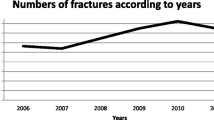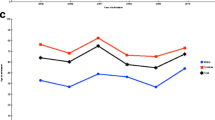Abstract
Background
Studies that investigated possible associations between the complexity of proximal humeral fractures and patient characteristics are rare. We hypothesized that the grade of fracture complexity may correlate with age and gender of hospitalized, adult patients.
Methods
Based on the Neer classification, we defined four radiological grades of fracture complexity. The data of adult patients that were treated during a 9-year period at a German hospital serving a town of 80,000 inhabitants was reviewed.
Results
Seven hundred and eighty fractures were evaluated [518 female/262 male (66.41/33.59 %), average age 64.2 years (range 17.4–99.2)]. During the study period, the number of fractures increased to 167 %. Almost two-thirds of the patients were females and older than 60 years. Of all fractures, 86 % were displaced fractures. In patients younger than 60 years, 1.99-fold more complex fractures occurred in males (32.4 %) than in females (16.2 %). In contrast, in patients older than 60 years, 1.72-fold more complex fractures occurred in females (54.1 %) than in males (31.5 %). There was a significant association between low-energy trauma and female gender older than 60 years.
Conclusions
Our study demonstrated an overall increase of displaced proximal fractures. The vast majority of patients with more complex fractures consisted of female patients older than 60 years.




Similar content being viewed by others
References
Palvanen M, Kannus P, Niemi S, Parkkari J. Update in the epidemiology of proximal humeral fractures. Clin Orthop Relat Res. 2006;442:87–92.
Bell JE, Leung BC, Spratt KF, Koval KJ, Weinstein JD, Goodman DC, Tosteson AN. Trends and variation in incidence, surgical treatment, and repeat surgery of proximal humeral fractures in the elderly. J Bone Joint Surg Am. 2011;93:121–31.
Lippuner K, Popp AW, Schwab P, Gitlin M, Schaufler T, Senn C, Perrelet R. Fracture hospitalizations between years 2000 and 2007 in Switzerland: a trend analysis. Osteoporos Int. 2011;22:2487–97.
Court-Brown CM, Garg A, McQueen MM. The epidemiology of proximal humeral fractures. Acta Orthop Scand. 2001;72:365–71.
Kristiansen B, Barfod G, Bredesen J, Erin-Madsen J, Grum B, Horsnaes MW, Aalberg JR. Epidemiology of proximal humeral fractures. Acta Orthop Scand. 1987;58:75–7.
Sonderegger J, Simmen HP. Epidemiology, treatment and results of proximal humeral fractures: experience of a district hospital in a sports- and tourism area. Zentralbl Chir. 2003;128:119–24.
Edelson G, Saffuri H, Obid E, Vigder F. The three-dimensional anatomy of proximal humeral fractures. J Should Elb Surg. 2009;18:535–44.
Neer CS 2nd. Displaced proximal humeral fractures. I. Classification and evaluation. J Bone Joint Surg Am. 1970;52:1077–89.
Neer CS 2nd. Four-segment classification of proximal humeral fractures: purpose and reliable use. J Should Elb Surg. 2002;11:389–400.
Neer CS 2nd. Displaced proximal humeral fractures. I. Classification and evaluation. J Bone Joint Surg Am. 1970;52:1077–89.
Jacob RP, Kristiansen T, Mayo K, Ganz R, Muller ME. Classifications and aspects of treatment of fractures of the proximal humerus. In: Bateman JE, Welsh RP, editors. Surgery of the shoulder. Philadelphia: BC Decker; 1984. p. 330–43.
Tamai K, Hamada J, Ohno W, Saotome K. Surgical anatomy of multipart fractures of the proximal humerus. J Should Elb Surg. 2002;11:421–7.
Meyer DC, Espinosa N, Hertel R. Combined fracture of the greater and lesser tuberosities with intact connection of the humeral head to the shaft. J Trauma. 2006;61:206–8.
Bahrs C, Schmal H, Lingenfelter E, Rolauffs B, Weise K, Dietz K, Helwig P. Inter- and intraobserver reliability of the MTM-classification for proximal humeral fractures: a prospective study. BMC Musculoskelet Disord. 2008;9:21.
Habermeyer P. Fracture of the head of the humerus. Unfallchirurg. 1997;100:820–37.
Bahrs C, Schmal H, Lingenfelter E, Rolauffs B, Weise K, Dietz K, Helwig P. Inter- and intraobserver reliability of the MTM-classification for proximal humeral fractures: a prospective study. BMC Musculoskelet Disord. 2008;9:21.
Mittlmeier TW, Stedtfeld HW, Ewert A, Beck M, Frosch B, Gradl G. Stabilization of proximal humeral fractures with an angular and sliding stable antegrade locking nail (Targon PH). J Bone Joint Surg Am. 2003;85-A Suppl 4:136–46.
Hertel R, Hempfing A, Stiehler M, Leunig M. Predictors of humeral head ischemia after intracapsular fracture of the proximal humerus. J Should Elb Surg. 2004;13:427–33.
Edelson G, Kelly I, Vigder F, Reis ND. A three-dimensional classification for fractures of the proximal humerus. J Bone Joint Surg Br. 2004;86:413–25.
Kannus P, Palvanen M, Niemi S, Sievanen H, Parkkari J. Rate of proximal humeral fractures in older Finnish women between 1970 and 2007. Bone. 2009;44:656–9.
Lippuner K, Johansson H, Kanis JA, Rizzoli R. Remaining lifetime and absolute 10-year probabilities of osteoporotic fracture in Swiss men and women. Osteoporos Int. 2009;20:1131–40.
Neer CS 2nd. Four-segment classification of proximal humeral fractures: purpose and reliable use. J Should Elb Surg. 2002;11:389–400.
Statistisches Bundesamt Wiesbaden. Bevölkerung Deutschlands bis 2060. Begleitmaterial zur Pressekonferenz Berlin 18 November 2009.
Lanting B, MacDermid J, Drosdowech D, Faber KJ. Proximal humeral fractures: a systematic review of treatment modalities. J Should Elb Surg. 2008;17:42–54.
Misra A, Kapur R, Maffulli N. Complex proximal humeral fractures in adults—a systematic review of management. Injury. 2001;32:363–72.
Thanasas C, Kontakis G, Angoules A, Limb D, Giannoudis P. Treatment of proximal humerus fractures with locking plates: a systematic review. J Should Elb Surg. 2009;18:837–44.
Handoll HH, Ollivere BJ. Interventions for treating proximal humeral fractures in adults. Cochrane Database Syst Rev. 2010;CD000434.
Bahrs C, Badke A, Rolauffs B, Weise K, Zipplies S, Dietz K, Eingartner C. Long-term results after non-plate head-preserving fixation of proximal humeral fractures. Int Orthop. 2010;34:883–9.
Acknowledgments
We would like to thank Mrs. Barbara Ketterle (M.A.) for the English translation of this publication
Conflict of interest
The authors declare that they have no conflict of interest.
Author information
Authors and Affiliations
Corresponding author
About this article
Cite this article
Bahrs, C., Bauer, M., Blumenstock, G. et al. The complexity of proximal humeral fractures is age and gender specific. J Orthop Sci 18, 465–470 (2013). https://doi.org/10.1007/s00776-013-0361-x
Received:
Accepted:
Published:
Issue Date:
DOI: https://doi.org/10.1007/s00776-013-0361-x




